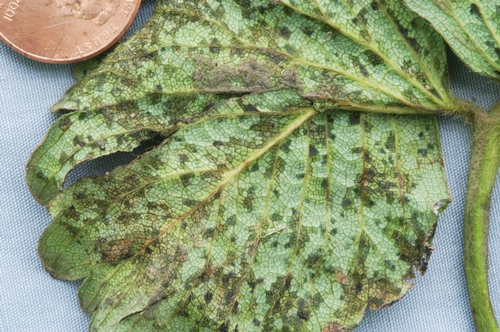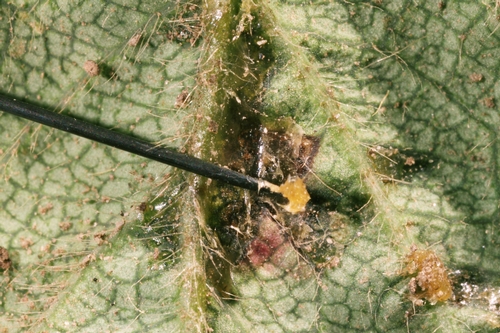Identification: Angular leaf spot (ALS) of strawberry is a familiar disease to growers and PCAs who are experienced with this crop. It occurs to some extent every season in coastal California. Like most bacterial diseases of crops grown in our region, ALS development and spread is dependent on splashing water; therefore, this disease is typically active only during the winter and early spring months when rains occur in California. Symptoms consist of small (from 1/16 to 1/8 inch wide) spots that first become visible on the lower surfaces of the leaves and have distinctive, straight margins at the edges of the spots (photo 1). Because of these straight edges, the spots have a rectangular or angular shape. Early in disease development the spots appear water-soaked; as disease progresses, the spots turn brown as the leaf tissue becomes necrotic. The upper leaf surfaces will also show the angular spots, with surrounding tissues turning red or yellow (photo 2). The bacteria that cause ALS often ooze to the surface of the lesions, resulting in a sticky film that covers the spot surface (photo 3). As this sticky matrix dries, the exuded bacteria form a crystalline, amber layer.
Spots can merge together, causing much of the leaf tissue to become necrotic and diseased. ALS is readily observed by holding leaves up against sunlight or other light source, which readily highlights the rectangular spots. ALS typically is restricted to the lower, older foliage of the strawberry plants. By the time the rains cease and the plants are vigorously growing, ALS will not occur on newly formed leaves that grow in the summer and fall. ALS does not occur on strawberry petioles, stems, or fruit. On occasion ALS can be observed on the green calyx attached to the developing strawberry fruit.
Situation in 2011: Because of the unusual occurrence of significant rainfall in the months of April and May, ALS is continuing to occur in strawberry fields and is spreading to additional foliage. Therefore, the disease is persisting later into the growing season than usual.
The pathogen: ALS is caused by the pathogenic bacterium Xanthomonas fragariae (Xf). This bacterium has a very narrow host range and only affects strawberry. Likewise, the Xanthomonas pathogens that cause bacterial leaf spot of lettuce (Xanthomonas campestris pv. vitians) and black rot of crucifers (Xanthomonas campestris pv. campestris) will not infect strawberry.
Disease cycle: For production strawberry in central coast California, the initial inoculum usually comes in with the strawberry transplants. However, since Xf can survive in the soil on strawberry plant residues, it is possible for Xf to carry over from one strawberry crop to another if back-to-back plantings are made. Bacteria in the strawberry transplants become active as the plants grow and are spread to leaves and adjacent plants by sprinkler irrigation (used to establish the transplants) and rains.
Impact and management: For production strawberry in California, ALS generally is of low concern. There is no documentation that ALS has any significant lasting effect on strawberry plants, and researchers have not documented significant yield reductions due to this disease. The actual strawberry fruit are not susceptible to infection. Management options are therefore not generally needed and in any case are limited. Use transplants that do not harbor the bacterium. Copper foliar sprays can be applied, but these applications are not very effective and can cause phytotoxic damage to the strawberry plants. Resistant cultivars are not available. In some situations, strawberry plants or fruit (with attached calyces) infected with Xf may be subject to quarantine regulations if being moved out of the state of California.
Attached Images:

Symptoms of angular leaf spot consist of distinctive leaf spots that have straight edges; such lesions are never circular or oval.

In severe cases, spots can merge together and cause much of the leaf to become necrotic.

The pathogenic bacteria ooze to the leaf surface and cause a sticky film to cover the leaf spot surface. Here a needle has been used to scrape bacteria from the surface of a spot.